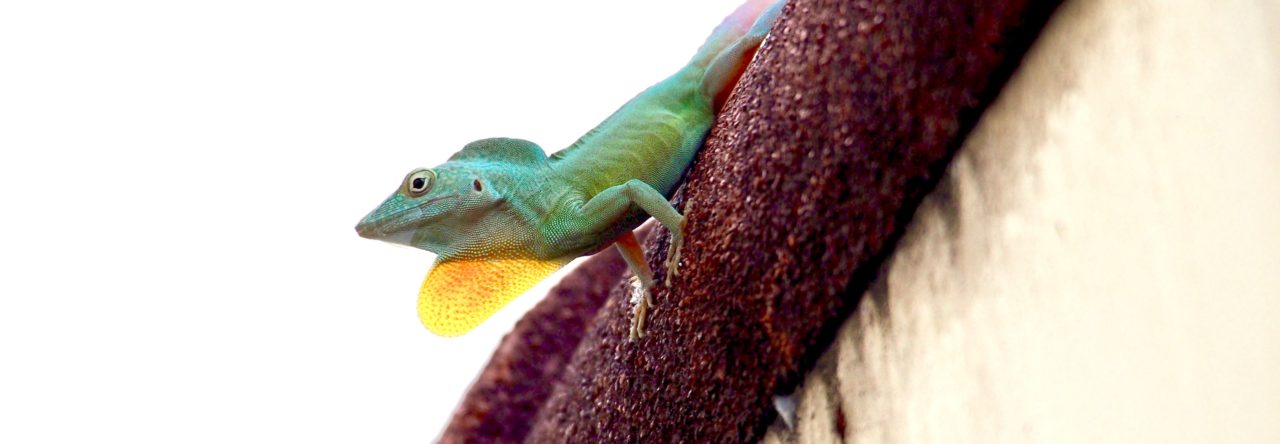
Anolis jubar. Photo by Miguel Landestoy
Two months ago, Masakado Kawata summarized the ongoing collaborative research program between Tohoku University in Japan, Habana University and the National Museum and Natural History of Cuba. The first fruit of this research has now been published in this month’s issue of Ecosphere (lead author Antonio Cádiz recently received his Ph.D. from Tohoku).
 The paper is the result of an impressive field research program in which 12 species of Cuban trunk-ground anoles were studied at 34 sites throughout the breadth of Cuba. The abstract pasted below provides the nitty-gritties (and, of course, read the paper yourself), but here are some of the interesting take-home messages:
The paper is the result of an impressive field research program in which 12 species of Cuban trunk-ground anoles were studied at 34 sites throughout the breadth of Cuba. The abstract pasted below provides the nitty-gritties (and, of course, read the paper yourself), but here are some of the interesting take-home messages:
1. Three species–A. allogus, A. homolechis, and A. sagrei–are widespread throughout Cuba, but the remainder have localized distributions.
2. Co-occurring species are a phylogenetically random subset of the clade, a result that obtains because of the combination of localized and widespread species that co-occur (four can occur in sympatry and five in an area).
3. Sympatric species are ecologically overdispersed, with species occupying different thermal microhabitats co-occurring.
4. Both A. allogus and A. jubar are paraphyletic with deeply divergent, geographically disjunct clades. The authors treat the clades as different species, and perhaps it is time for someone to formally describe them as such.
5. Anolis delafuentei–known, if I’m not mistaken, from a single individual–defied efforts to recollect it. Is this a real species? Is it extant?
Overall, this is an excellent study that could serve as model for the study of other species-rich ecomorph clades, both on Cuba (e.g., alutaceus group) and elsewhere.
Abstract:
Variations in species richness of local assemblages may be explained by local ecological processes or large-scale evolutionary and biogeographical processes. In Anolis lizards, species with different ecomorphs can coexist by occupying different niches. In addition, several species with the same ecomorph (e.g., trunk-ground) can coexist, and the number of trunk-ground anole species varies among local species assemblages. In this study, we assessed the importance of ecological interactions, number of speciation events, and range expansion for local and regional species diversity of these lizards. We examined the species richness and thermal microhabitat partitioning (considered to be a measure of ecological interaction) of 12 trunk-ground anole species in 11 local assemblages in Cuba. The results indicated that the phylogenetic structure of trunk-ground anole lizard assemblages was random. However, there was an overdispersion of preferences for thermal microhabitat use, which indicates that differences in microhabitat use are likely to occur within assemblages. We suggest that the number of speciation events within regions and the number of sympatrically coexisting species increases species richness at the local level. Migration appeared to be limited, leading to the range expansion of only three species with different thermal requirements. The thermal niches of species were conserved within Anolis allogus clade, whereas species within the Anolis homolechis and Anolis sagrei clades tended to change their thermal niches. Our results suggest that the species composition and richness in local assemblages could be explained by evolutionary history (the number of speciation events and limits to range expansion) and ecological processes (habitat partitioning). Of the ecological factors, the number of thermal (microhabitat use) and structural niches (e.g., vegetation) could limit the potential number of coexisting species within a local assemblage.
- Evolution in Real Time on Lizard Island - March 23, 2025
- Spider Snags Adult Anolis osa - March 22, 2025
- An Homage to the Green Anoles of New Orleans - March 21, 2025




1 Pingback